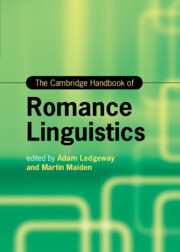Book contents
- The Cambridge Handbook of Romance Linguistics
- Cambridge Handbooks in Language and Linguistics
- The Cambridge Handbook of Romance Linguistics
- Copyright page
- Dedication
- Contents
- Figures
- Tables
- Contributors
- Abbreviations
- 1 Data, Theory, and Explanation: The View from Romance
- Part One What Is a Language?
- Part Two Phonetics and Phonology
- Part Three Morphology
- Part Four Syntax
- 16 Argument Structure and Argument Realization
- 17 Agreement
- 18 Alignment
- 19 Complex Predicates
- 20 Dependency, Licensing, and the Nature of Grammatical Relations
- 21 Parametric Variation
- Part Five Semantics and Pragmatics
- Part Six Language, Society, and the Individual
- Index
- References
18 - Alignment
from Part Four - Syntax
Published online by Cambridge University Press: 23 June 2022
- The Cambridge Handbook of Romance Linguistics
- Cambridge Handbooks in Language and Linguistics
- The Cambridge Handbook of Romance Linguistics
- Copyright page
- Dedication
- Contents
- Figures
- Tables
- Contributors
- Abbreviations
- 1 Data, Theory, and Explanation: The View from Romance
- Part One What Is a Language?
- Part Two Phonetics and Phonology
- Part Three Morphology
- Part Four Syntax
- 16 Argument Structure and Argument Realization
- 17 Agreement
- 18 Alignment
- 19 Complex Predicates
- 20 Dependency, Licensing, and the Nature of Grammatical Relations
- 21 Parametric Variation
- Part Five Semantics and Pragmatics
- Part Six Language, Society, and the Individual
- Index
- References
Summary
The term ‘alignment’ is used in the typological literature to characterize the morphosyntactic behaviour of arguments and their relationship to the predicate. The term usually refers to case, agreement, and word order. Within the Romance family, Latin and its descendants are considered to display basic nominative-accusative alignment. However, Latin also has a split intransitive subject alignment in certain paradigms of the verbal system. This split alignment continues in a variety of guises into later Romance varieties. In this chapter, we discuss these phenomena in some detail, highlighting microvariation within the Romance family and discussing their importance for our broader understanding of alignment. We focus on the diachrony of alignment, as a backdrop for the discussion of the synchronic situation in Romance languages. We discuss auxiliary selection and the alignment of past participle agreement, charting both frequent and rare splits. Subsequently, we focus on alignment in SE-passives and word order in Romance. Finally, we briefly discuss two other potentially relevant phenomena: INDE-cliticization and absolute participles/participial adjectives. As we shall see, in many of these cases, the Romance language family displays a remarkable array of alignment patterns which raise interesting challenges for theories of split-intransitivity and alignment more generally.
Keywords
- Type
- Chapter
- Information
- The Cambridge Handbook of Romance Linguistics , pp. 544 - 570Publisher: Cambridge University PressPrint publication year: 2022



